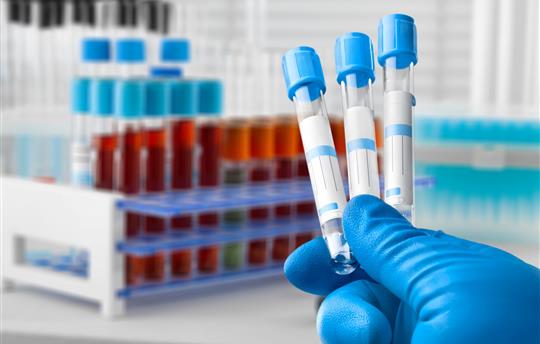10 Laboratory Labels Vital for Testing and Patient Care
8/15/2024

Laboratory tests have an immense impact on diagnostic and treatment decisions in the healthcare market — in fact, 70% of today’s medical decisions depend on laboratory test results, according to the Centers for Disease Control and Prevention (CDC). If a step in the testing process gets disrupted, however, it can cause problems that range from a delayed diagnosis to a need to redraw a specimen. Or, it can cause the more serious consequence of patient misidentification.
It’s routine for laboratories to perform tests that guide patient care and allow healthcare providers to confirm a diagnosis, build a treatment plan, and manage and monitor a patient's condition. Making all of this possible: a laboratory label, which provides positive patient identification and other essential details. Without a lab label, specimens can get rejected and patient safety can be compromised, creating an increasing workload for the care team.
Information that lab labels must include
To protect patients from adverse errors that could occur due to improperly labeled specimens, each lab label must contain the following legible information (a specimen is incompletely labeled if any of the required information is missing):
- Patient name
- Patient medical record number, with check digit
- Patient location
- Collection date and time
- Specimen type and/or source
- Test required (note any special handling required)
- Ordering physician
In addition, although specimen containers are typically sent in a transport bag, the actual specimen must also be labeled. It’s unacceptable to label only the bag or other container used to transport the specimen.
What happens if specimens are mislabeled or improperly labeled? Typically, if specimens are received unlabeled, double-labeled, or contain a requisition with a name and/or medical record number different from what’s affixed to the specimen, they will not be tested. Further, if improper labeling causes the specimen to be rejected, redrawing the specimen may be required.
Beyond the role they play in laboratory tests, labels can also communicate precautions to the laboratory staff, warning against the safety concerns chemicals can create. The Occupational Safety and Health Administration (OSHA) requires labeling of containers of chemicals in the lab, as well as containers of chemicals being shipped to other workplaces.
10 essential laboratory labels
The following 10 types of laboratory labels can help to facilitate laboratory workflows, and they’re essential when it comes to labeling specimens and communicating safety precautions to lab staff:
Biohazard labels: Used in conjunction with OSHA’s Exposure Control Plan, biohazard labels help to eliminate or minimize occupational exposure to bloodborne pathogens by identifying equipment, containers, rooms, and materials that potentially or actually contain hazardous elements.
Consecutive number labels: In addition to being utilized for patient samples and specimens, consecutive number labels can be used to track a range of lab assets. Numbering also allows a specimen to be delivered to the clinical staff and patient while maintaining a patient’s anonymity during analysis.
Cryogenic laboratory labels: Cryogenics are used in hospital labs to freeze biological samples such as stem cells, plasma, cells, and strains. Cryogenic laboratory labels are specially engineered to withstand cryogenic refrigerators and liquid nitrogen over an extended period of time.
Laboratory colored tape: Capable of simplifying the color-coding of equipment, instruments, charts, and more, laboratory colored tape can also be utilized on lab benches to improve workflow by indicating “new,” “in process,” and “complete.”
Laboratory information systems (LIS) labels: These labels simplify the process of differentiating a lab's samples, reagents, or plates. LIS labels displaying a unique barcode are the most effective way to track and keep these items separate.
Laboratory specimen labels: Laboratory specimens undergo three distinct steps — collection, transportation, and processing. Specimen labels ensure positive patient identification through each phase.
Microscope slide labels: Microscope slide labels can be used on all types of microscope slides — glass, fiberglass, plastic — including wet- and dry-mounted varieties. Typically labeled on the frosted end, these labels include the accession number, slide designation, and patient name.
OSHA and GHS safety labels: Designed to communicate chemical hazards, OSHA and GHS labels provide an instant reminder to lab employees of any chemical hazards. In addition, they simplify the labeling of secondary containers with OSHA-required information.
Quality control labels: In addition to testing and specimen analysis, laboratories also manage reagents, instruments, and more. Quality control labels help to track and manage these items.
Warning storage labels: Warning storage labels can mark receptacles that contain common reagents and hazardous materials.
Playing a crucial role
Lab labels help ensure proper specimen collection, transport and processing, meet Joint Commission labeling requirements, protect patients and staff, and more. With 14 billion laboratory tests ordered annually according to the CDC — from common blood count tests to a screening for the bacteria that causes anthrax — it’s crucial that accurate patient identification and other important details be provided. Lab labels can supply laboratories with that assurance.
The information presented in this blog was originally published by RRD’s United Ad Label, which produces stock and custom lab labels designed to improve the specimen workflow and patient and staff safety. Contact UAL to learn more about stock and custom labels for laboratories and other applications.